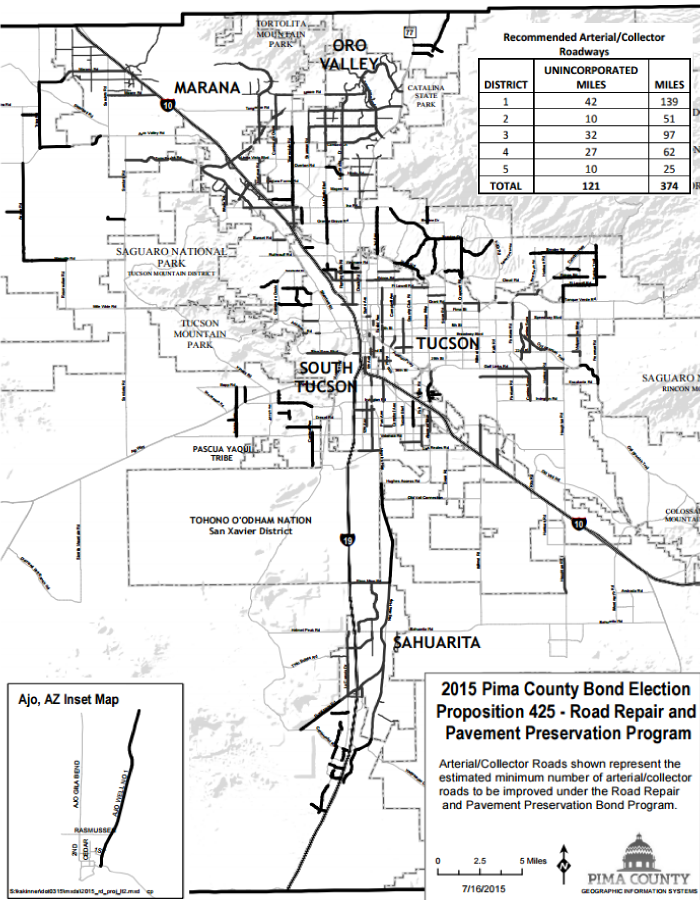
Seven Pima bond propositions to be voted on November 3 are headed by Proposition 425, “Road and Highway Improvements.” Those “improvements” include $30 million for the Sonoran Corridor, a proposed interstate benefiting Raytheon, Diamond Ventures, University of Arizona Tech Park and linking to County Administrator Chuck Huckelberry’s planned Interstate 11 highway through the Avra Valley. Prop. 425 includes a $10 million road for the UA Tech Park, which contributed $10,000 to the Yes campaign alongside Diamond Ventures’ $25,000.
The selling point, and probably why this proposition is first on the ballot, are politically popular road repairs. On July 17 Huckelberry sent a memo to the Board of Supervisors with a map of possible road repair targets. He also told the Supervisors to set up a Pavement Preservation Commission to make final decisions. That commission would have seven members, one each appointed by the supervisors, and two appointed by Huckelberry.
With Picture Rocks a focal point of opposition to an Avra Valley interstate, it is perhaps no surprise that the rural community of 10,000 people receives only one small token “repair.” That is a small section of Orange Grove Road west of Sandario, a road that does not have a lot of traffic or a lot of problems from what this driver can observe. Huckelberry also personally insisted that a modest expansion of the Picture Rocks Community Center be stricken from the list of bond proposals.
“GROSSLY INADEQUATE”
Using bond money for road repairs is risky. Bonds take time to sell, and there’s a good chance that repairs made may well be undone before the bonds are actually paid off. Geri Otoboni-Gilmore writes on the Taxpayers Against Pima Bonds website, “Oro Valley, Marana and Sahuarita, in Pima County, have been repairing their roads with current tax and HURF funds (gas tax and license plate fees). If these towns can be responsible, why can’t Pima County? This bond will actually cost taxpayers approximately $338 Million with principal, interest, operation and maintenance costs.”
Marla Closen, running against Supervisor Ray Carroll in the 2016 Republican primary, adds, “Last year, we received $63.2 from the transportation fund, yet of this $63.2 million in funding, only about $16 million was used for pavement preservation and maintenance. Why? $5 million was used for pavement preservation (of which more than half was moved into the General Fund), $14 million was used for road maintenance, $19 million was used to pay our 1997 bond debt, $6 million was used to subsidize the RTA and the remaining $19 million was used for engineering and ’overhead.’”
Huckelberry himself, In a July 23 memo to the Supervisors, said, “…no more than 30 percent of our needs are being met” by the $200 million “Road and Highway Improvement” bonds. He called the bonds “grossly inadequate … not the solution…” and urged another tax: “We need to fund these essential public services from direct, transportation related revenues; preferably the gas tax or an excise tax on the sale of gasoline or diesel fuels.”
Although the election is not until November 3, the Board of Supervisors will be taking up implementation of the bonds at their September 15 meeting.
Pima County Prop 425 – Road Repair and pavement Preservation Program from Chuck Huckleberry July 17 memo

